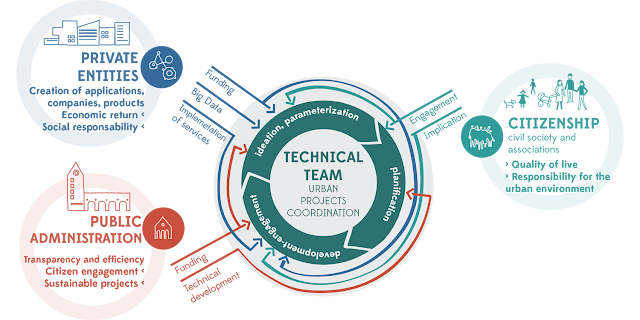Boosting Integrated Urban Sustainable Development
• 1604 Views • No hay comentarios en Boosting Integrated Urban Sustainable Development- Cohesive and inclusive city. A city that invites and welcomes individuals regardless of their social reality, offering high levels of quality in design and urban equipment. A city that provides coverage and attention to social needs, that enhances spaces that favour social blend and where coexistence translates into respect.
- Closest city, accessible, connected. An urban environment in which the people move without difficulty regardless of age and physical condition. The close and convenient access to daily necessities makes our day more pleasant.
- Active and productive city. A city that produces basic consumer needs, offers employment opportunities, and at the same time, integrates new economic, cultural and social activities to build a critical and intelligent society.
- City and diverse identity. The attachment to one’s territory, to the place where one lives, and the desire for its improvement, are based on sense of identity; this is why new cities have to build their identity and image outwards, towards already existing settlement or urban areas. The mixture of people with diverse identities is what builds the human support of the city; thus, a city where live people of different backgrounds, ages, cultural and economic levels, is a rich city.
- Healthy and resilient city. Health is a growing concern in our societies, to improve it is necessary to have spaces and time devoted for exercise, avoid the impacts of pollution and acquire healthy habits related to food, transportation or housing. Similarly, the impacts of climate change, increasingly present, require responses for adaptability of new cities to ecological issues related to climate, rising sea levels, etc.
- Efficient and functional city. Technology enables us to run cities more efficiently in areas as diverse as energy and water improvement or for public service improvement.
- Prioritization of public space on the neighbourhood, district and city scales, in relation to suitable design for inclusive and vibrant public use and taking into account the design and uses of the adjoining buildings.
- Green infrastructure and biodiversity continuousness in the urban fabric.
- Planning typological diversity of housing: collective, detached, closed open block, mixed, etc., as well as models of multiple and complementary management: sale, rent, rent to own, etc.
- Sustainable transport networks, with a network for efficient but bounded private motorized transport, where the priority is soft mobility, public transport, pedestrian routes and cyclists’ lines.
- Hierarchical and planned services network according to standards of proximity and endowment per capita, with educational coverage, cultural, health, social welfare and basic services equipment.
- Mix and flexibility of uses for economic activity. Availability of land and various spaces for the implementation of offices, cultural activities, workshops, small industries, etc.
- Infrastructure and efficient urban services management and maintenance, as well as public use. Monitoring services for efficiency.
- Development of an identity cultural discourse, with a new image and branding for the new development. This cultural discourse must configure itself based on location, origin and future perspectives; it must disseminate the existing identity imaginary and be flexible enough to allow modification by citizens.
- A transparent administration of the city that fosters growing governance spaces. A transversal administrative structure equipped with tools of coordination between the various municipal areas, which promote efficiency of public administration and participatory spaces. Transparency, Access to Public Information and Good Governance.
- Adaptive Planning. Given the difficulty of designing a city in a closed manner when its inhabitants do not yet exist and when the process will last several years, we propose a system of adaptive planning. The proposed design must be able to be reviewed periodically taking into account the problems encountered during the development, and the comments of new neighbours. It also considers that there is a forecast of temporary uses for spaces that take several years to begin and run definitely. This improvement of urban planning we call Meanwhile Urbanism.
Image credits:
Image 01: Urban stakeholders (font: Paisaje Transversal)
Image 02: The city for the people (font: Paisaje Transversal)
Related Posts
« X BIAU llegará a Sao Paulo en el próximo mes de octubre – centrourbano.com (Comunicado de prensa) (blog) Escultura y urbanismo: el equilibrio de la mano de Lorente – El Observador »

 Technorati
Technorati Flickr
Flickr del.icio.us
del.icio.us Ice Rocket
Ice Rocket Wikipedia
Wikipedia

